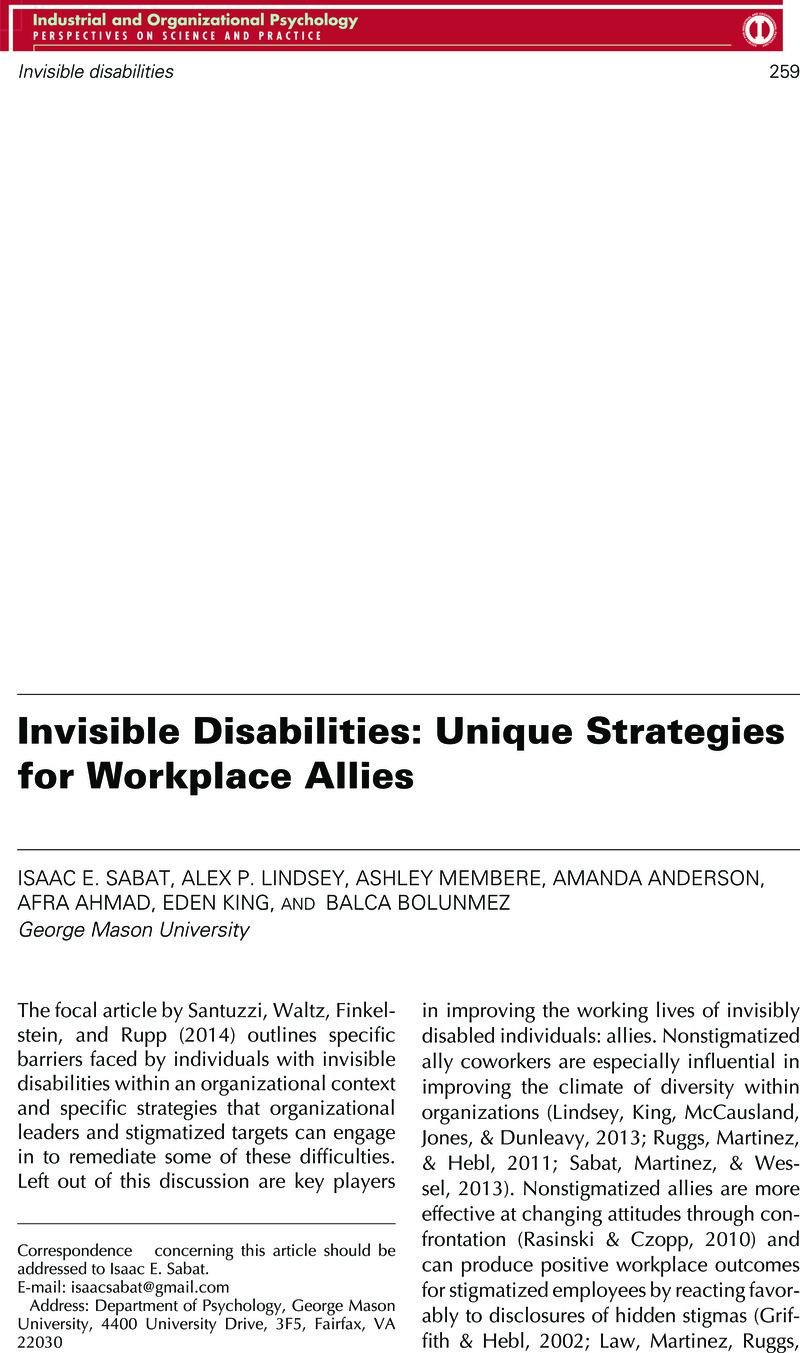Crossref Citations
This article has been cited by the following publications. This list is generated based on data provided by Crossref.
Cheung, Ho Kwan
King, Eden
Lindsey, Alex
Membere, Ashley
Markell, Hannah M.
and
Kilcullen, Molly
2016.
Research in Personnel and Human Resources Management.
Vol. 34,
Issue. ,
p.
101.
Alaybek, Balca
Dalal, Reeshad S.
Sheng, Zitong
Morris, Alexander G.
Tomassetti, Alan J.
and
Holland, Samantha J.
2017.
Situational Strength Cues from Social Sources at Work: Relative Importance and Mediated Effects.
Frontiers in Psychology,
Vol. 8,
Issue. ,
Cheng, Shannon
Ng, Linnea
Trump-Steele, Rachel C. E.
Corrington, Abby
and
Hebl, Mikki
2018.
Calling on Male Allies to Promote Gender Equity in I-O Psychology.
Industrial and Organizational Psychology,
Vol. 11,
Issue. 3,
p.
389.
Salter, Nicholas P.
and
Migliaccio, Leslie
2019.
Diversity within Diversity Management.
Vol. 22,
Issue. ,
p.
131.
Smith, Rachel Williamson
Hulett, Anna L.
and
Maples-Keller, Jessica L.
2019.
Personality testing and the Americans With Disabilities Act: An applicant/employee perspective.
Industrial and Organizational Psychology,
Vol. 12,
Issue. 2,
p.
167.
Cook, Samantha
and
Clement, Kristina
2019.
Navigating the hidden void: The unique challenges of accommodating library employees with invisible disabilities.
The Journal of Academic Librarianship,
Vol. 45,
Issue. 5,
p.
102007.
Santuzzi, Alecia M.
Keating, Robert T.
Martinez, Jesus J.
Finkelstein, Lisa M.
Rupp, Deborah E.
and
Strah, Nicole
2019.
Identity Management Strategies for Workers with Concealable Disabilities: Antecedents and Consequences.
Journal of Social Issues,
Vol. 75,
Issue. 3,
p.
847.
Hebl, Mikki
Cheng, Shannon K.
and
Ng, Linnea C.
2020.
Modern Discrimination in Organizations.
Annual Review of Organizational Psychology and Organizational Behavior,
Vol. 7,
Issue. 1,
p.
257.
Bonaccio, Silvia
Connelly, Catherine E.
Gellatly, Ian R.
Jetha, Arif
and
Martin Ginis, Kathleen A.
2020.
The Participation of People with Disabilities in the Workplace Across the Employment Cycle: Employer Concerns and Research Evidence.
Journal of Business and Psychology,
Vol. 35,
Issue. 2,
p.
135.
Johnson, Tiffany D.
Joshi, Aparna
and
Hogan, Toschia
2020.
On the front lines of disclosure: A conceptual framework of disclosure events.
Organizational Psychology Review,
Vol. 10,
Issue. 3-4,
p.
201.
Murphy, Lauren D.
Thomas, Candice L.
Cobb, Haley R.
and
Hartman, Alexius E.
2021.
A review of the LGBTQ+ work–family interface: What do we know and where do we go from here?.
Journal of Organizational Behavior,
Vol. 42,
Issue. 2,
p.
139.
Collins, Joshua C.
Zhang, Panpan
and
Sisco, Stephanie
2021.
Everyone is Invited: Leveraging Bystander Intervention and Ally Development to Cultivate Social Justice in the Workplace.
Human Resource Development Review,
Vol. 20,
Issue. 4,
p.
486.
Zak, K.P.
Popova, V.V.
Orlenko, V.L.
Furmanova, O.V.
and
Tronko, N.D.
2021.
Cytokines in the blood of patients with type 2 diabetes mellitus depending on the level of overweight/obesity (literature review and own data).
INTERNATIONAL JOURNAL OF ENDOCRINOLOGY (Ukraine),
Vol. 17,
Issue. 7,
p.
534.
Saeed, Abubakr
Kehkishan, Sundas
and
Sameer, Muhammad
2022.
Divorce status in the Pakistani workplace: women's narratives on stigma, outcomes and coping strategies.
Equality, Diversity and Inclusion: An International Journal,
Vol. 41,
Issue. 6,
p.
927.
Wissell, Shae
Karimi, Leila
Serry, Tanya
Furlong, Lisa
and
Hudson, Judith
2022.
“You Don’t Look Dyslexic”: Using the Job Demands—Resource Model of Burnout to Explore Employment Experiences of Australian Adults with Dyslexia.
International Journal of Environmental Research and Public Health,
Vol. 19,
Issue. 17,
p.
10719.
Griffith, Jennifer
Malone, Mary Fran T.
and
Shea, Christine M.
2022.
From bystander to ally among faculty colleagues: construction and validation of the bystander intervention behavior scale.
Equality, Diversity and Inclusion: An International Journal,
Vol. 41,
Issue. 2,
p.
273.
Kreiner, Glen
Mihelcic, Christine A.
and
Mikolon, Sven
2022.
Stigmatized Work and Stigmatized Workers.
Annual Review of Organizational Psychology and Organizational Behavior,
Vol. 9,
Issue. 1,
p.
95.
Nittrouer, Christine L.
Dean, Evan E.
and
Shogren, Karrie A.
2022.
Generation A.
p.
45.
Liu, Joseph T.
and
Mendez, Maria J.
2022.
The Attributional–Counterfactual Theory of Need: Integrating Theories to Predict Need Norm Use.
Business Ethics Quarterly,
Vol. 32,
Issue. 1,
p.
103.
Vilches Gonzalez, Maria Jose
George, Leya
Miteva, Lidia
and
Singh, Aneesha
2023.
Developing Empathy towards Experiences of Invisible Disabilities Through Games.
p.
1.



